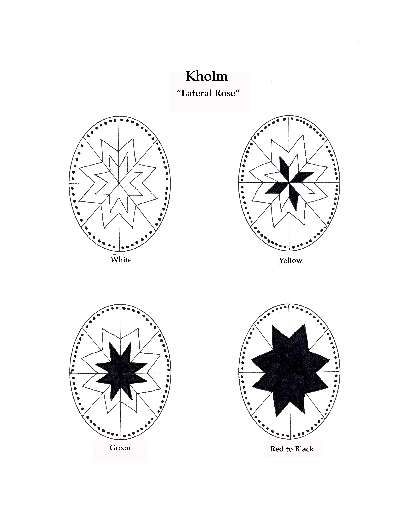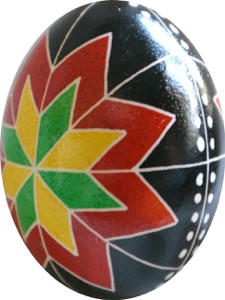Kholm
Холмщина
Kholm
Холмщина

This pysanka can be found in several sources; the earliest that I have is Elyjiw’s Plast stamps, where it is one of two Kholm pysanky and is simply referred to as a “rozha.” Binyashevsky included both of Elyjiw’s Kholm pysanky in his book, and renamed this one «Зірки» (zirky, “stars”). Onyshchuk also included it in her book, and she called it a «бокова рожа» (bokova rozha, “lateral rozha”).
This is a classic example of of a «рожа» (rozha). It is a sun symbol, the classic eight-pointed star, one of the most common motifs in pysankarstvo. It is often referred to as a rozha or ruzha because of its floral shape. A rozha is not a rose (that would be a троянда/troyanda), but a mallow–or other–flower. It is an ancient word with Indo-European roots that is used, with various modifiers, to describe a whole host of Ukrainian flowers.
The «бокова» (bokova, “lateral”) refers to the location of the motif on the egg. This is a common design, a large rozha centered on each side of a pysanka. It is also a classic «повна» (povna, “full”) rozha, which refers to its appearance: a double rozha, or a rozha within a rozha.
Kholm is one of Ukraine’s lost territories. A formerly ethnic Ukrainian area, it’s lands became part of modern-day Poland after WWII. Kholmshchyna was ethnically cleansed by resettlement of ethnic Ukrainians either to various parts of the Ukrainian SSR or to other parts of Poland. It is located between Volyn and the Polish province of Lublin, along the Buh river. It is a somewhat hilly, largely agricultural area. The city of Kholm was the capital of the Galician-Volynian state in 1235, under Prince Danylo.
Pysanky from this region are largely geometric, although there is not a huge amount of material to generalize from. The three examples (total) given by Elyjiw and Onyshchuk consist of the pysanka above and a sorokoklyn with dark backgrounds, and a red egg with linear spirals and suns. Manko’s book has added 26 new examples of Kholm pysanky to the literature; these eggs have, with rare exception, red or dark red/brown backgrounds, and simple linear geometric and phytomorphic designs written in yellow (and not, for the most part, white). Their level of complexity range is moderate (although none approach those from the Hutsul regions).

Technical details: This is a moderately simple pysanka, as it is largely linear (no curls), and can be attempted by beginners. It has a basic “Star” division.
As with most simple traditional designs, a medium or heavy stylus is best for the lines, and of course a heavy one for waxing in and for creating the dots.
This pattern utilizes yellow, green, red and black dyes. The green can be applied either by spot dyeing, or you can dye the entire egg green and then remove it with an orange rinse prior to coloring it red.
The line width in the example above should probably been a bit heavier. A traditional pysanka such as this, with a simple design, would traditionally have heavier (medium) lines.
Download this pattern sheet:
Back to MAIN Patterns page.
Back to MAIN Regional Pysanky page.
Back to MAIN Traditional Pysanky page.
Search my site with Google
Lateral Ruzha
Бокова Ружа
